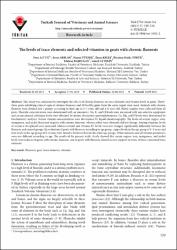The levels of trace elements and selected vitamins in goats with chronic fluorosis

Göster/
Erişim
info:eu-repo/semantics/openAccessTarih
2013Yazar
Altuğ, NuriArslan, Sezai
Yüksek, Nazmi
Keleş, İhsan
Yörük, İbrahim Hakkı
Başbuğan, Yıldıray
Aytekin, İsmail
Üst veri
Tüm öğe kaydını gösterÖzet
This study was conducted to investigate the effects of chronic fluorosis on trace elements and vitamin levels in goats. Thirty-three goats exhibiting clinical signs of chronic fluorosis and 10 healthy goats from the same region were used. Animals with chronic fluorosis were divided into 2 groups according to their age as 1-3 years old and 4-6 years old. Blood samples were collected from all goats. Fluoride concentrations were determined with an ionometer. Na, K, and Cl levels were measured with ion-selective equipment and serum mineral substance levels were obtained by atomic absorption spectrophotometer. Ca, Mg, and P levels were determined by biochemistry analyzer. Serum vitamin concentrations were determined by liquid chromatography. The levels of serum copper, iron, manganese, and nickel decreased in goats with chronic fluorosis, whereas other trace elements did not change. Among vitamins, levels of serum a-tocopherol were increased, whereas retinol and vitamin D3 levels were not changed significantly differently between the fluorosis and control groups. In evaluation of goats with fluorosis according to age group, copper levels in the age group of 1-3 years and iron levels in the age group of 4-6 years were found to be lower than in the other age groups. Other minerals and all vitamin parameters were not different according to age. The results of the present study clearly showed that serum copper, iron, manganese, and nickel levels were reduced in goats with chronic fluorosis, and so goats with fluorosis should receive support in terms of these concerned trace elements.

















